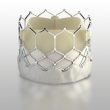At present, the transfemoral access (TFA) is the preferred approach when it comes to transcatheter aortic valve replacement (TAVR). However, 5 to10% of PAD patients present tortuous iliac anatomy and calcification, aortic aneurysms or prior peripheral intervention, which makes it impossible. There are several alternatives to approach these patients: 1) TFA associated to peripheral PCI...
ACC 2023 | TAVR in Low Risk Patients: 3-Year Outcomes
At present, transcatheter aortic valve replacement (TAVR) has become the gold standard in the US, regardless surgical risk. The current ACC and AHA guidelines recommend that a Heart Team make the decision for 65 to 80-year-old patients with aortic stenosis. In low risk patients, fast recovery and short term benefits of TAVR should be weighed...
TAVR and New Onset LBBB
The safety and efficacy of transcatheter aortic valve replacement (TAVR) is already established. However, it still poses a challenge for conduction disturbances, such as the need for pacemaker or new onset left bundle branch block (LBBB). The current rate for the latter ranges from approximately 11% to 19%. In most cases, 50% of LBBB reverses...
Real-World Results of Different Devices for TAVR
Transcatheter aortic valve replacement (TAVR) keeps growing in terms of the development of new devices, more extensive operator experience, and enhanced procedure planning. Nowadays, there are multiple device options, which depend on patient characteristics and operator experience. Two-arm studies compared these devices, analyzing the potential benefits of a certain valve over the others. This multicenter...
Clinical Implications of the Presence of HALT in TAVR Patients: 5-Year Follow-Up
The duration of percutaneous aortic valve implants can be increasingly observed over time, regardless of their corresponding surgical risk. In the follow-up of different registries, the presence of subclinical valvular thrombosis, evidenced in tomographic studies as an increase in valvular thickness with hypoattenuation (a term known as HALT), was observed from protocolized images. This subclinical...
We Should Treat Significant Stable CAD in Patients Undergoing TAVR
Aortic stenosis is associated to significant coronary artery disease (CAD) in nearly 50% of cases. When we decide to treat aortic disease using surgery, it has been established we should also treat heart disease. However, when using transcatheter aortic valve replacement (TAVR), this is still unclear, given that in many occasions we see stable lesions...
We Should Start Considering Pulmonary Hypertension After TAVR
Pulmonary hypertension is associated with higher mortality after both aortic valve replacement and transcatheter aortic valve replacement (TAVR). This is a dynamic phenomenon, and what happens after TAVR —during the periprocedure— and its impact are yet to be evaluated. Researchers conducted a subanalysis of the Japanese OCEAN TAVI Registry, which included 1872 patients who were divided...
Is Right Ventricle-Pulmonary Artery (RV-PA) Coupling Important in Low Risk TAVR?
TAVR has long been an effective strategy to treat aortic stenosis. However, ventricular damage starts further before symptom onset, also affecting the left ventricle, pulmonary vessels, the right ventricle, the tricuspid valve, and the right atrium. It increases arterial afterload and uncouples the right ventricle and the pulmonary artery, defined by transthoracic echocardiogram as the relationship...
TCT 2022 | PROTECTED TAVR
Stroke is still a major complication of transcatheter aortic valve replacement (TAVR), with a 30-day mortality of 16.7%. Even in the absence of symptoms, most patients (68-93%) have some type of diffusion imaging defect after TAVR implantation. The Sentinel cerebral protection device (CPD) (Boston Scientific) received FDA approval for the capture of emboligenic material that...
Apixaban and Valve Thrombosis after TAVR
TAVR has been associated with early valve thrombosis, characterized by thrombus formation in the prosthetic valve with or without valve dysfunction. This dysfunction is related to leaflet thickening and reduced motion, reduced effective orifice area, or increased transvalvular gradient. A multidetector CT scan allows the dynamic assessment of valves and ruling out fibrosis vs. thrombosis. ...









